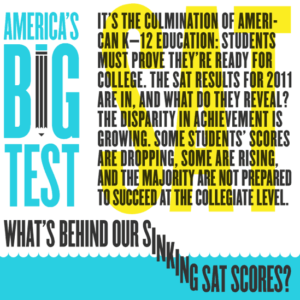Less Than Half Of the 2011 SAT-Taking Class Is Expected to Succeed In College
 This week, the Hewlett Foundation launched a contest to boost assessments in critical thinking and problem solving. Yet, when we take a look at our current testing systems such as the SAT, America’s biggest test determining a K-12 culmination of knowledge in math, reading, and writing, this year’s 2011 graduates are expected to fall short.
This week, the Hewlett Foundation launched a contest to boost assessments in critical thinking and problem solving. Yet, when we take a look at our current testing systems such as the SAT, America’s biggest test determining a K-12 culmination of knowledge in math, reading, and writing, this year’s 2011 graduates are expected to fall short.
Recent studies show that students scoring as least a 1,550 on the SAT have a 65 percent chance of maintaing a B-average Freshman year. Most strikingly, less than half of the 2011 SAT-taking class is expected to succeed in college.
Score gaps between demographics has dramatically increased, especially as more students taking the SAT come from bilingual households. These statistics raise concerns that the SAT scoring system actually hurts minority or low-income demographics’ chances at college.
While scores decline and show greater disparities, colleges and universities today place an increased emphasis on high school grades, extracurricular activities, and admission essay when considering college admissions. For more, view the data below from OnlineAssociatesDegree.com.

Created by: Online Associates Degree





David J Hickson
It is interesting to see the parallels between this analysis and PISA scores -that big, bad international test at the core of all of the "USA students are falling behind: hubbub. Overall, the USA falls well down the list, in the company of countries like Poland, Hungary, and Portugal, and well behind list leaders like Singapore, Finland, and Hong Kong.
However, what is not often touted by politicians is that resource-rich American schools (typically in the suburbs), as a subset, fall right among the PISA list leaders. Resource-deprived students in communities that face the range of socioeconomic challenges drag down the overall national performance. Rather than serving as a damning indictment of our schools, an understanding of PISA score patterns instead illustrates the terrible societal impact of the widening socioeconomic gap in the United States.
The trends in scores among various populations paint a dismal picture - we are losing our gains in the past century of leveling the playing field for people from different ethnic and socioeconomic groups. Very sad news indeed.
Gretchen Knoblock
Is there any data linking curriculums to test scores? And also, any data relating reading levels in middle schools to college scores? (taking into account those who have dropped out, (many of whom drop out due to reading difficulties, and therefore failure in classes). I'd be curious to see what that data showed. (and also which curriculums the highest achievers use, or if they both use the same curriculums).
Replies
Tom Vander Ark
Great question, hard to answer. Historically, many people thought of curriculum as adopted textbook. The quality of instruction (the enacted curriculum) has proven to be more important than differences in textbooks (see big recent study, http://obs.rc.fas.harvard.edu/chetty/value_added.html). I think of curriculum as a sequence of learning experiences around a set of expectations--and that intersects with school culture, support systems, schedule, structure, and community connections. In other words, your question gets complicated fast.